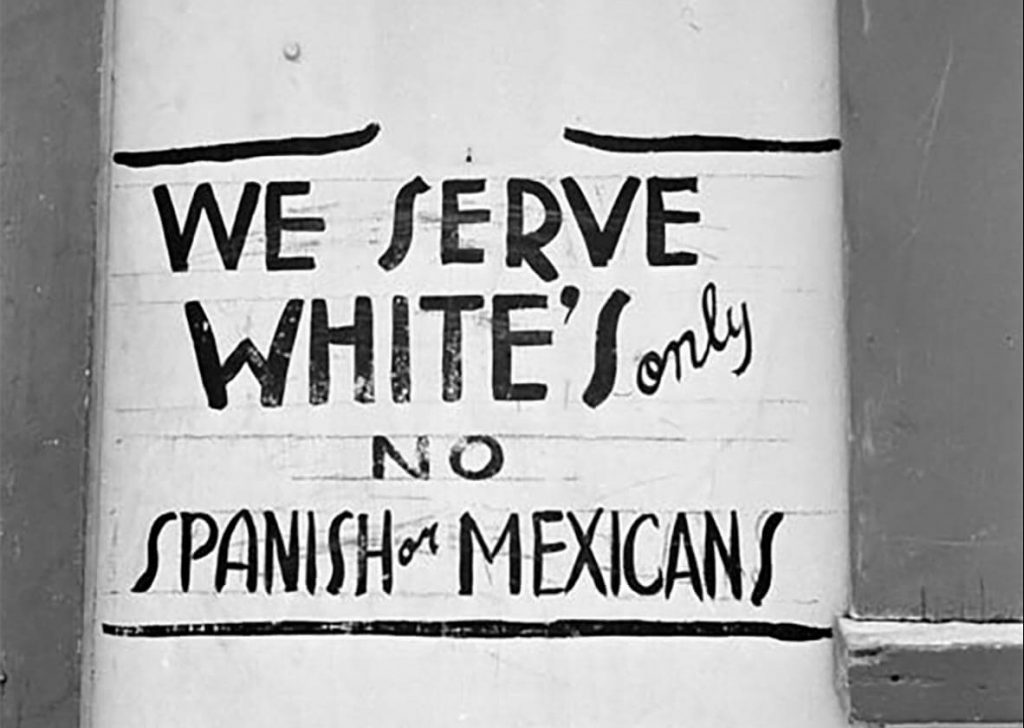1911, Antonio Gomez, a fourteen-year-old Mexican-American boy, was walking home carving pieces of wooden shingles, when suddenly a saloon owner shoved him to the street. Gomez was scolded by the saloon owner for littering on the sidewalk shouting, “the sidewalk is no wastebasket.” A group of men that was at the saloon cheered on the owner and cursed at Gomez. As the boy gathered his shingles and tried to leave, a man by the name of Charles Zieschang snatched the wooden shingles from the boy’s hand and told the owner he could, “make the damn little skunk quit whittling.” Zieschang whipped Antonio Gomez with his own wooden shingles while other men watched and ridiculed the boy. Out of self-defense Antonio Gomez stabbed Zieschang with the pocket knife he was using to carve the wooden shingles. Zieschang died from blood loss in twenty minutes.1

Mexican-Americans were somewhat immune to the racist Jim Crow policies of the south that made discrimination against black Americans legal. This was due to the fact that Mexicans were “white by law” since the signing of the Treaty of Guadalupe Hidalgo in 1848. So, the Juan Crow laws emerged as a way to legally discriminate against Mexican Americans. Through Juan Crow prejudices, Texas passed English-only laws that led to future segregation of Mexican-Americans in school systems. Anglos pushed for segregation of Mexican-Americans in school because they believed having their children learn alongside Mexican-American children would hinder them. Segregationists also believed that it was safer for their white children because they believed Mexican-Americans reached puberty earlier. Unsurprisingly the anti-Mexican efforts were blind-sided by authorities across the state giving more power to Juan crow laws that essentially justified discrimination and mistreatment of Mexican-Americans.2

Antonio Gomez was taken into custody almost immediately by constable McCoy and taken into the town jail of Thorndale, Texas. Soon after his arrest, another version of the altercation went around. Some were claiming that Gomez was the attacker who waited for Zieschang to come out of the saloon after having snatched his wooden shingle and peacefully retreating to the saloon. The people were so eager to bring their own “justice” that they were willing to act as witnesses without having seen anything. Although history has yet to prove which story is the most accurate, the only part that remains constant is the events that led up to his death. Gomez became an instant target for lynching because the citizens knew he was too young for capital punishment in the state of Texas, but they were willing to take matters into their own hands. It was reported that a mob of more than a hundred people waited for justice outside the jail. Constable McCoy who placed Gomez in jail tried to transfer him to another jail out of fear that the boy would be lynched by the people. The constable knew that the small jail could keep Antonio Gomez in, but he wasn’t sure that it could keep an angry mob out. Gomez was led through the back of the jail with a chain around his neck and straight to a house. McCoy went to look for reliable transportation to another jail while Gomez was kept in a safe place, or so he thought. Somehow the angry mob learned the location of Antonio Gomez and managed to steal him from authorities.3
Racism had grown its roots very deep and brutally here in the state of Texas. Racism in Texas stems back not only to slavery and the prejudice towards black people, but to native Americans as well. Mexicans were sometimes saved by the law which would recognize a Mexican person as “white” as long as their skin permitted it. If you were not of fair skin, then you risked being persecuted. Most Anglo-Americans had an “us versus them” mentality when it came to Mexican-Americans. This was because many Anglo-Americans picked up on American nationalism and nativism going against Mexican-Americans who were wrongly stereotyped. Mexican-Americans were usually seen as inferior, violent, and even anti-American. Racism against Mexican-Americans was like a double-edged sword. Mexican-Americans had to deal with Anglo-Americans who did not accept them and did not think they were American enough. Simultaneously, Mexican-Americans dealt with Mexicans who also thought less of Mexican-Americans, often times looking at them as traitors. Racism in the state of Texas was not only on the mere surface, but it had also been implemented systematically, from the school systems to the housing system and even the labor systems. This is because our country’s story is based on a consensus history, which means that our history is based on points of view that seeks to paint an exciting picture of our history, and downplaying the tragedies that occurred.4

Antonio Gomez was captured by an angry mob and was dragged by a horseman who managed to grab the chain that was around Gomez’s neck. Antonio Gomez’s body was found lifeless hanging from a telegraph pole next to a ladder. Only three hours had passed since the death of the man that Gomez was charged for “murdering.” The body of the child was found bruised up and beaten horribly with a chain around his neck. After beating the boy and dragging him, the men mercilessly suspended his body from the pole. Before the men managed to hang his body, they had a failed attempt where they dropped his body and kicked his head. The constable was too late when he arrived at the scene.5
How common were these anti-Mexican lynching’s? Although hateful crimes against Mexicans were common, it was not so common to be recorded for history. There are records to show that from 1848 to 1928 at least 597 deaths of Mexicans in Texas were due to mob violence or lynchings. These attacks directed towards Mexicans and Mexican-Americans were not only done by other citizens, but they were also planned systematically by Texas Rangers. Another example of brutal deaths by mob violence is the lynching and burning of Antonio Rodriguez. These acts of terror were very common in Texas, especially towards ethnic groups such as African Americans, Mexicans, and even native Americans even earlier.6

It is important to know the stories of such victims of racism and mob violence like that of Antonio Gomez or even of Jesse Washington. Although these stories are not the most appealing, it is important to recognize these people and their stories because it is our history whether we like it or not. It is important for all people to know the truth. Stories like these are even relevant today. We could look at recent laws such as SB4 that encouraged racism among law enforcement, or even the stereotypes that current president Trump has promoted. The story of Antonio Gomez shows just how far and systematic racism has been in our state of Texas or even in our country. It is important to know the entire truth of history, not just one point of view. Why haven’t you heard of Antonio Gomez? Why was Mexican-American studies just recently added to the Texas public school curriculum in 2014, and only as an elective? Why isn’t the history of Mexican people in our textbooks when it is a vital part of who we are and where we come from, especially here in Texas?
- Nicholas Villanueva,The Lynching of Mexicans in the Texas Borderlands (Albuquerque: University of New Mexico Press, 2017), 125; George T. Diaz, “A Review of the Lynching of Mexicans in the Texas Borderlands,” Southern Spaces, no. 1 (2018): https://southernspaces.org/2018/review-lynching-mexicans-texas-borderlands/ . ↵
- George T. Diaz, “A Review of the Lynching of Mexicans in the Texas Borderlands,” Southern Spaces, no. 1 (2018): https://southernspaces.org/2018/review-lynching-mexicans-texas-borderlands/. ↵
- Nicholas Villanueva,The Lynching of Mexicans in the Texas Borderlands (Albuquerque: University of New Mexico Press, 2017), 125. ↵
- Marlon Bishop and Julia Shu, “The History of Anti-Mexican Violence and Lynching” Latino USA, no. 1(2016): 1-2, https://www.latinousa.org/2016/03/11/the-history-of-anti-mexican-violence-and-lynching/; William D. Carrigan, Forgotten Dead: Mob Violence Against Mexicans in the United States (Oxford: Oxford University Press, 2013), 77. ↵
- Nicholas Villanueva,The Lynching of Mexicans in the Texas Borderlands (Albuquerque: University of New Mexico Press, 2017), 125, http://search.ebscohost.com/login.aspx?direct=true&db=nlebk&AN=1423320&site=eds-live&scope=site; George T. Diaz, “A Review of the Lynching of Mexicans in the Texas Borderlands,” Southern Spaces, no. 1 (2018): https://southernspaces.org/2018/review-lynching-mexicans-texas-borderlands/ . ↵
- William D. Carrigan, Forgotten Dead: Mob Violence Against Mexicans in the United States (Oxford: Oxford University Press, 2013), 77. ↵



58 comments
Alyssa Ramos
Texas has some dark history that not many are familiar about. As a Mexican-American, I have realized that our history isn’t really taught in our school curriculum. I feel as the Texas curriculum hides many parts of history out due to the fact they do not believe it is important enough to teach. It is important for us to learn all parts of history, including the dark history, so we won’t make the same mistakes. I have never really looked into Mexican-American history myself, but after reading this article I am going to do further research. Mexican-Americans, and many different races, have been discriminated against for many years and that is a huge part of American history. I believe if we start teaching kids, in school, at a young age that discrimination is not okay, we will be able to change the way America runs.
Madeline Chandler
This is such a well written engaging article. An extremely captivating and informative article that shows a dark part of Texas history. I have been familiarized with Jim Crow laws yet I’ve never heard of Juan crow laws. It’s very upsetting that Mexican-American citizens were treated so poorly for their heritage. Such an hard story to read about a child, Antonio Gomez, being inhumanely treated for something he didn’t do wrong. Job well done! Thoroughly enjoyed it!
Lucia Saks
I thought this article is such an important article fro everybody but especially Mexican-Americans to read. Before reading this I had no idea that Juan Crow laws existed or even that lynching was not exclusive to black Americans but other minorities as well. As a Mexican-American I knew that discriminations against Mexican-Americans occurred and have even faced discrimination even though I am considered white passing it is so discouraging to think about how hard of a past Mexican-Americans have had and the discrimination that is still occurring today.
Diego Oviedo
The article was amazing and the information given was new honestly. I did not know about Juan Crow laws, and that’s interesting because why wouldn’t Juan Crow laws be known? I don’t think that my history classes every touched the subject of Juan Crow laws, which is interesting because one would think it would be an important topic to learn about. The story of Antonio Gomez is sad and it goes to show how even now similar things are going on.
Eric Hernandez
I completely agreed with this entire article, especially the ending. I feel like our government doesn’t stress the urgency of racism enough. It really shows in our everyday lives by reading all of the stories of tragic events having to with racism. Once I finished reading the article, it left me thinking, “when are we going to put a stop to racism and how?”
Cayden Garcia
First off I just wanna say great article, Paul. I had never heard of Juan Crow laws until this article. It is crazy to think a whole nother set of racist laws existed at the same time as Jim Crow laws. I can’t believe all because of where people were born they were discriminated against.
I do have one question for you. Why do you think Jim Crow laws get talked about so much more than Jaun crow laws?
Again great article, thank you for the information!
Alexa Montelongo
As a Mexican-American, I too have noticed the lack of Mexican-American history that is not taught in our schools curriculum. I have had the opportunity to do some extensive research on the lynchings of Mexican-Americans during my senior year of high school and was shocked that my high school was apart of the schools that were segregated. Furthermore, I also have had the opportunity to talk to alumni from Thomas Jefferson high school who have witnessed lynchings in the Jefferson area and the racism that was exhibited within the school.
Alicia Martinez
As a student at St. Mary’s, I have the wonderful opportunity to learn more about Latin culture and Mexican- American history. With that being said, I am astonished to find out that I am not very educated on injustice faced by Mexicans within Texas. The history books in our public schools often pick and choose what parts of history to share, and it has become disturbingly apparent that most students are unaware of such social injustices that took place such as the lynching of 14-year-old Antonio Gomez. Additionally, I am dumbfounded to learn about Juan Crow laws that, unfortunately, “justified ” legal action to discriminate Mexican’s, not only by the color of their skin but also through the lengthy spoke and the culture they carried.
Alexis Lopez
As a Hispanic it is rare to hear anything about my culture or how things started this was the main reason why I wanted to read this article because I wanted to learn something about my culture. I have always been curious about Mexican history because it is so rare when we even hear about it or talk about especially in classes. I knew that there was racism amongst Mexican and Mexican American, but I did not know about all these lynching’s that had took place in Texas. It’s interesting to learn about these stories to show how long racism has been around. I also thought it was interesting how if you were Mexican or Mexican American and you had a fair skin tone then you can probably get a pass on all these racist laws. It frustrates me that they barley added Mexican American studies to public schools after so long and also that it took long to even learn about the Mexican American culture or impact.
Savannah Alcazar
I had no idea this was a part of American history. They do not teach that Mexicans were “white by law” since the signing of the Treaty of Guadalupe Hidalgo in 1848 in schools. Or anything about the Juan Crow laws that emerged as a way to legally discriminate against Mexican Americans. I had only learned about the injustice done to the African American demographic around that time period.